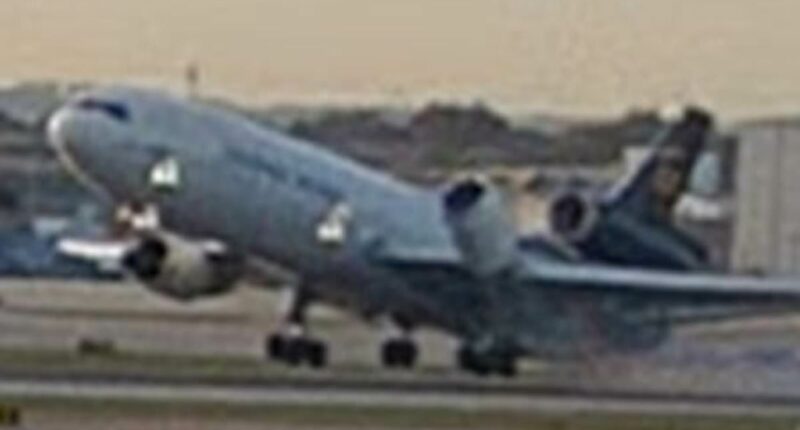Share this @internewscast.com
An engine from a UPS aircraft was witnessed breaking away from a wing and soaring into the air just before the jet collided in a fiery crash, resulting in the deaths of 14 individuals in Kentucky.
The National Transportation Safety Board (NTSB) has published a preliminary report on the tragic event that occurred on November 4. This incident claimed the lives of three crew members aboard the McDonnell Douglas MD-11 aircraft, as well as 11 people on the ground.
The report is accompanied by alarming images showing UPS Flight 2976 departing from Louisville Muhammad Ali International Airport when a massive blaze erupted, causing one of the plane’s three engines to detach.
The cause of the engine’s detachment remains unknown. The report details how it separated from the pylon, the component connecting the engine to the wing, as the aircraft sped down the runway during takeoff.
The NTSB investigation revealed that a fire ignited on the left engine, which then moved “above the fuselage and subsequently impacted the ground.”
Photographs included in the report depict flames emerging mere seconds after the engine broke away, indicating that the fire might have resulted from the detached engine hitting a fuel-laden wing.
Despite the inferno consuming the left side of the cargo plane, the aircraft cleared the airport’s fence but never made it more than 30ft above the ground, the report stated.
It crashed in an enormous fireball seconds later.

The National Transportation Safety Board released a preliminary report on Thursday of the devastating November 4 incident that killed three crew members and 11 people on the ground

A massive plume of fiery smoke is seen in the air after the devastating plane crash
Included in the report were statements from two witnesses in the Air Traffic Control tower who told NTSB the speed of the MD-11 appeared normal.
The witnesses did say the airplane did fly into the sky normally ‘before rolling slightly to the left’, per the report.
Following the fatal crash, federal investigators discovered the plane’s left pylon air mount, which helps keep the engine in place, has ‘fatigue cracks in addition to areas of overstress failure’, according to the report.
Louisnes Fedon and his three-year-old granddaughter, Kimberly Asa, were two of the victims who lost their lives in the crash.
Another victim was also identified as Matt Sweets, 37, who survived the initial explosion but later succumbed to his injuries after 95 per cent of his body was burned.
John Spray, 45, was tragically killed after the plane crashed into Grade A Auto Parts & Recycling, where he was working at the time.
Ella Petty Whorton, 31, also died while working at the recycling business, which was owned by Spray.
Beloved mom Angela Anderson, 45, Carlos Fernandez, 52, Trinadette Chavez, 37, Tony Crain, 65, John Loucks, 52, and Megan Washburn, 35, were also killed in the crash.
Captain Richard Wartenberg, First Officer Lee Truitt and Relief Officer Dana Diamond, also died along with first officer Lee Truitt and Captain Dana Diamond.
After the tragedy, UPS ‘temporarily grounded’ its MD-11 fleet, the company announced.


Louisnes Fedon and his three-year-old granddaughter, Kimberly Asa, were two of the victims who lost their lives in the crash

Matt Sweets, pictured here, survived the initial explosion but later succumbed to his injuries after 95 per cent of his body was burned

Beloved mom Angela Anderson, 45, also died in the crash
‘Out of an abundance of caution and in the interest of safety, we have made the decision to temporarily ground our MD-11 fleet,’ UPS said in a statement.
‘We made this decision proactively at the recommendation of the aircraft manufacturer,’ the statement added.
‘Nothing is more important to us than the safety of our employees and the communities we serve. Contingency plans are in place to ensure we can continue to deliver the reliable service our customers around the world count on.’
While Flight 2976’s deadly crash remains under investigation, aviation experts have shared unsettling details about the MD-11 jet.
‘The model was antiquated by the time it came out – except, of course, for cargo. It’s a workhorse,’ Mary Schiavo, a former US Department of Transportation Inspector General, told USA Today.
The MD-11 has the second-worst safety record of all commercial planes still in operation, according to Boeing data published in April.
The model was launched in 1990 as a passenger jet, but due to its poor fuel efficiency and high maintenance costs, it was retired from commercial flights in 2014 and has since been used only as a cargo plane.
‘It had kind of a reputation of being a hard airplane to land,’ Ross Aimer, the CEO of Aero Consulting Experts and a longtime United Airlines pilot, told the outlet.
The specific MD-11 that crashed on Tuesday was manufactured in 1991 by McDonnell Douglas, now owned by Boeing. UPS purchased it in 2006.

A member of the US Air National Guard is seen surveying the horrible damage left behind from the crash on November 5
‘The age may play a role, but as long as any airplane is well-maintained, it can last forever,’ Jeff Guzzetti, a former NTSB investigator and air-safety consultant, told The Wall Street Journal.
Records reviewed by the WSJ indicated that the plane that took the fatal flight was grounded in San Antonio, Texas, from September 3 to October 18 because it needed a permanent repair to fix a crack in its fuel tank.
Echoing Guzzetti’s sentiment, aviation consultant Mike Boyd told CNN: ‘At UPS, I would not be concerned about airplane age.
‘The main issue for operators is increasing maintenance costs, which US carriers don’t take lightly, and fuel burn.’
As of early this year, there are more than 80 active MD-11 planes operating for FedEx Express, UPS Airlines and Western Global Airlines.





